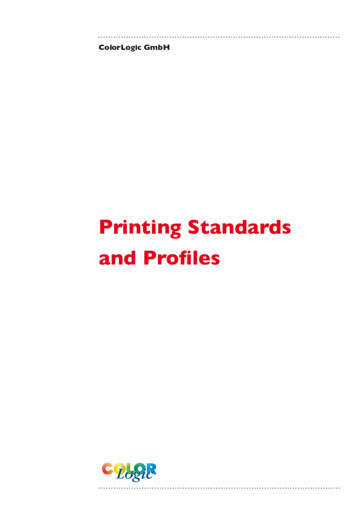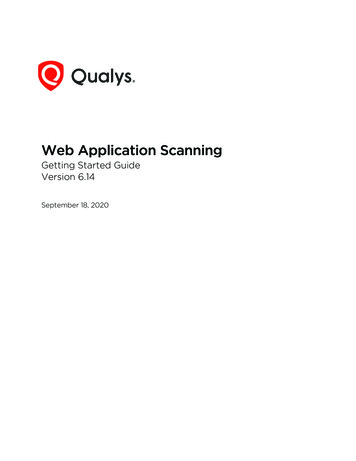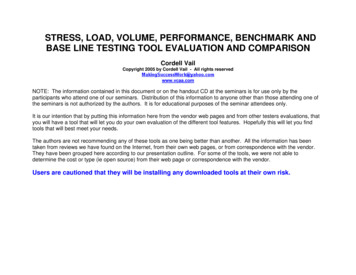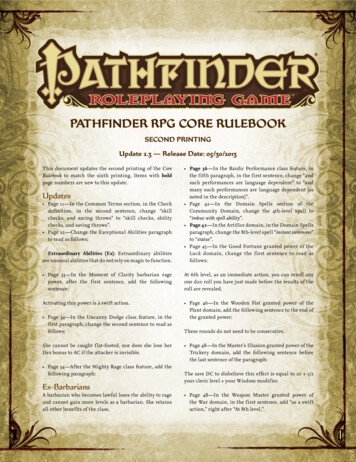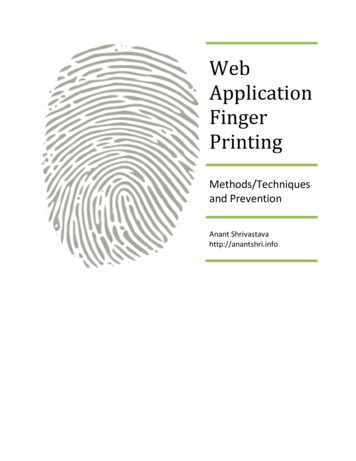
Transcription
WebApplicationFingerPrintingMethods/Techniquesand PreventionAnant Shrivastavahttp://anantshri.info
Table of ContentsAbstract. 3Theory of Finger Printing and Web Application Finger printing . 3Usage of Web Application Finger Printing . 3Methods of Web Application Finger Printing . 3HTML Data Inspection . 4File and Folder Presence (HTTP response codes) . 5Checksum Based identification . 5Disadvantages of Current automated Solutions . 6Case Study of various Web Application finger printing Software’s. 6WhatWeb . 6Wapplyzer . 7BlindElephant . 7Plecost (Specialized Scanner for Wordpress). 10W3af Wordpress finger printer . 11Inherent Flaws in the Design of Current automation Tools. 12Thwarting Automated Web Application Finger Printing . 13HTML cleansing . 13File and folder Restrictions . 13Checksum Management . 14Static Text Files (HTML, JS, CSS). 14Image files (PNG, JPG, ICO, GIF) . 15Incremental chaos . 15Enhancing Current Tools and future directions . 16New Approach for Tools . 16Cross Referencing other techniques & using Human Common Sense in Tools . 16Conclusion. 17References . 17
AbstractThis Paper discusses about a relatively nascent field of Web Application finger printing, how automatedweb application fingerprinting is performed in the current scenarios, what are the visible shortcomingsin the approach and then discussing about ways and means to avoid Web Application Finger Printing.Theory of Finger Printing and Web Application Finger printingFinger printing in its simplest senses is a method used to identify objects. Same Term has been used toidentify TCP/IP Stack Implementation and was known as TCP/IP finger printing. And similar usage hasbeen extended lately to identify web applications Installed on the Http Server.If you know your enemies and know yourself, you can win a hundred battles without a single loss – TheArt of War (Chapter 3) in the same spirit Web Application finger printing is performed to identify theApplication and software stacks running on the HTTP Server. Web Application finger printing is at itsnascent stage as of now, however we are observing increasing awareness about it and large number ofautomated solution emerging in the market.Usage of Web Application Finger PrintingWeb Application finger printing is a quintessential part of Information Gathering phase [4] of (ethical)hacking. It allows narrowing / drilling down on specifics instead of looking for all clues. Also anAccurately identified application can help us in quickly pinpointing known vulnerabilities and thenmoving ahead with remains aspects. This Step is also essential to allow pen tester to customize itspayload or exploitation techniques based on the identification and to increase the chances of successfulintrusion.Methods of Web Application Finger PrintingHistorically Identification of Open Source applications have been easier as the behavior pattern and allthe source codes are publically open. In the early days web application identification was as simple aslooking in the footer of the Page of text like “Powered by XYZ ”. However as more and more Serveradmin became aware of this simple stuff so is the Pen Testers approach became more complex towardsidentification of web application running on remote machine.
HTML Data InspectionThis is the simplest method in which manual approach is to open the site on browser and look at itssource code, similarly on automated manner your tool will connect to site, download the page and thenwill run some basic regular expression patterns which can give you the results in yes or no. Basicallywhat we are looking for is unique pattern specific to web software.Examples of such patterns are1) WordpressMeta TagFolder Names in Link sectionEver green notice at the bottom2) OWAURL patternhttp:// site name /OWA/3) JoomlaURL pattern: http:// site name /component/4) SharePoint PortalURL Pattern: / layouts/*And similarly for majority of applications we can create regular expression rules to identify them.
These regular expression’s combined together as a monolithic tool to identify all in one go or as apluggable architecture for creating one pattern file for each type and work on it.Example of tools using this technique includes browser plugin’s like Wapplyzer and web technologyfinder and similar tools.File and Folder Presence (HTTP response codes)This approach doesn’t download the page however it starts looking for obvious trails of an applicationby directly hitting the URL and in course identifying found and not found application list. In starting daysof internet this was easy, just download headers and see if it’s 200 OK or 404 not found and you aredone.However in current scenario, people have been putting up custom 404 Pages and are actually sending200 OK in case the page is not found. This complicates the efforts and hence the new approach is asfollows.1) Download default page 200 OK.2) Download a file which is guaranteed to be non-existing then mark it as a template for 404 andthen proceed with detection logic.Based on this assumption and knowledge this kind of tools start looking for known files and folders on awebsite and try to determine the exact application name and version.Example of such scenario would bewp-login.php wordpress/owa/ Microsoft outlook web frontend.Checksum Based identificationThis is relatively a newer approach considered by far as most accurate approach in terms on applicationand specific version identification.This Technique basically works on below pattern.1) Create checksum local file and store in DB
2) Download static file from remote server3) Create checksum4) Compare with checksum stored in db and identifiedOne of the best implementation of this technique is Blind elephantDisadvantages of Current automated SolutionsAs you might have guessed these automation tools have certain disadvantages too.1) First and foremost these tools get noisy especially in auto detection modes.2) Large numbers of 404’s can immediately trigger alarms across the places.3) Secondly they generally rely on the URL pattern we gave and fail to look beyond that. Howeverit might be the case that site main link has reference links to its blog which might not beupdated and could open gates for us.4) They lack the humanly fuzziness. Case Study of various Web Application finger printing Software’sWhatWebProgramming Language: RubyThis is one of the beast application allowing a pluggable architecture with virtually any applicationdetection as you can see in the below script-let this software is performing following tasks.1)2)3)4)5)Google dork checkRegexp pattern matchingFile existence checkerFile Content checker based on file nameMd5 based matching.This effectively allows it to report application more accurately. As well as being pluggable in natureallows it to be customized for any application encountered.
WapplyzerProgramming Language: JScriptWapplyzer is a Firefox, Chrome Plugin, and works on only regular expression matching and doesn’t needanything other than the page to be loaded on browser. It works completely at the browser level and givresults in form of icon’s.BlindElephantProgramming Language: PythonThis is a new entrant in the market and works on the principle of static file checksum based versiondifference.As described by author at its home page, The Static File Fingerprinting Approach in One Picture
This again allows this software to work for both open-source software and closed source softwares, thecondition is that the person running BlindElephant need to have access to source code to map all staticfile fingerprinting.Basic logic is here :
Plecost (Specialized Scanner for Wordpress)Programming Language: PythonPlecost works on a simple principle of finding right files.It derives the version of Wordpress from readme.html as shown below:
This section works for all open source Wordpress plugin’s which are available from wordpress.org site.Basically it tries to fetch the readme.txt for each plugin and then based on that deduces the version ofappliance installed on this server.Note: wordpress.org makes it a mandate for every plugin author to have a correctly formed readme.txtfile and hence chances of finding these files are too large.W3af Wordpress finger printerProgramming Language: PythonW3AF aims to be the metasploit of web, and hence is attracting quite an attention now a day. Belowlisted is among the first hand plugin’s of web application finger printing in W3AF.This plugin again take a retro approach looks for exact file names and paths and moving on to look forspecific data inside the file and if exist then deduce that application is Wordpress. This highlight is tostress on the fact about paths and flaws which we will be discussing after this section.
Inherent Flaws in the Design of Current automation ToolsIf you have looked carefully in the above details you will find lots of alarming things.1) All the tools work on assumption and have very low chances of cross verifying themselves.They assume thata. Filename X means Z plugin. Orb. Folder Q in site means software is used irrespective of the actual usage of the productor not.2) Tools are very relaying (except blind elephant which give a probability) - over confidence isdangerousThese tools provide us results and in turn generate confidence; however everyone needs tounderstand that automated solution could also be fooled. And as such these tools should also benon authoritative in providing the output.3) They claim to be dynamic however remain static at large parts. (dynamics is only in replacing thefront domain name)If you careful observe above discussions on each of scanning solution, you will seeStatic path’sdependency on static filename4) As already suggested Noise can ring alarms.5) Even when we talk about checksum based approach then again we fail to remove the above 2constrains and on top of that we have a fundamental flow in this approach
Let’s analyze the statementComparing Static files at known locationDoes that rings some bell, known location is not necessary always the same example inWordpress we can change the folder location of wp-content as of now and in future we will beable to change other folder locations too (namely wp-admin, wp-include).Precomputed hashesEffectively telling me that the application has hashes pre-computed and as such doesn’t takeinto consideration that user will do any manipulation of file.Thwarting Automated Web Application Finger PrintingHTML cleansingThis is one of the oldest methods of controlling what you don’t what others to see.Few things to keep in mind.META or generator tags are not required and can be removed.Most free software’s ask you to give credit however they don’t explicitly mention that givecredit at footer of every page, you can customize that. Also any GPL product gives you theright to modify your content and keep it to yourself till you decide to sell it.Comments such as TO-DO / FIXIT if made should be kept at source code / programminglanguage control, avoid HTML comments for any information / clue.File and folder RestrictionsOne of the application specific finger printing applications is Plecost for Wordpress. As seen above itworks on a straight forward hit a file if 200 OK with valid content plugin exist otherwise doesn’t exist.Similar kind of approach could be easily thwarted by using simple htacess based rules or redirectionpolicies.Example to beat Plecost all you need is block access to readme.txt (.html) from outside.The reason why I suggest block and not removal as in case of removal during next upgrade all the fileswill be restored, however blocking will help in all cases.
#blocking access to readme.txt files readme.txt order allow,denydeny from all /files This should be enough to block access to readme.txt, similar steps could be performed to block majorityof other files/folders.What we are trying to do here is allow disallow everyone direct access to important filesChecksum ManagementThis particular section is a hypothetical section as of now describing theoretical approach to beating thechecksum based software versioning scheme. People are welcome to enhance this approach andintegrate this in the defensive tool chain.As already described above checksum based approach has inherent flaws in the design and hence couldbe forced to fall in its own trap. I have divided this part in 3 basic sections, text files, binary files, andincremental chaos.The general approach for all the below is as listed1) Change the path as path is one static link in the whole chain.2) We might not be able to change name so change content. (Name changing can take a lot of timeand effort not by pen tester but by developers to get things right.)Static Text Files (HTML, JS, CSS)This section will deal with various techniques you can use to thwart checksum’s.1) You can just manually edit all relevant file add just about any character even a single charactercan change the whole checksum.2) You can write a script to append text at the end of file.3) Preferred option would be to intermix the actual content with seemingly relevant content in thewhole text area.4) Things to keep in mind while performing this exercise would bea. If you insert text in between HTML keep check on tags like pre textarea text object span table , any of these tags may bark out in case you add somerandom text in between.b. Text to be inserted could be a normal comment or a complex comment made out ofrandom characters. It could also be a properly formatted and placed HTML data.c. Here again we need to be one step ahead and think how this protection could benullified, in case of comments a person can simply remove all comments from both ends
and then compare text. So we need to make sure our scrambler content is not justcomments but mix of comment and tags. Also tags should not be in predefined order /pattern otherwise regular expressions could be used to detect such material andremove it.d. In Java script you can add some random named function requesting some valid lookingrandom name div and span’s however keep in mind that the regular expressions shouldnot be able to isolate this particular text we add otherwise we fail the actual cause of it.e. In CSS we can work on the above tags generated in HTML and JS to hide or change dataon them.5) We need to make sure that data is not collated at one places rather spread across the whole file.Image files (PNG, JPG, ICO, GIF)Manipulating image files would be a much more daunting task as this involves binary files.Things we need to keep in mind1) Using any image conversion tool can degrade the quality of image.2) We need to maintain aspect ratio and resolution of all images.3) If manipulating at image level output quality should be hundred percent with no addedcompression.However we can still look at following prospective.1) Changing the alpha channel value i.e. changing transparency from 0 to 1% can significantlychange checksums and still retain image.2) Binary level edit by directly editing the binary file and adding exif data or extra data to the endof image data.3) Manipulating color code of a fully transparent pixel.Incremental chaosThis is my favorite part; as we are already trying to confuse the automated solutions why not add morespice to the recipe. So here is my next hypothetical solution which is targeted towards makingautomated solutions more useless. When we are trying to hide our actual platform why not providethem something to reliable determine and give result, in simple termsWe will hide our original software using above described approaches, effectively the software might givea no result, relying on the confidence these automated solution present why not make sure the outputis there and when reported with full confidence that could lead to lots of chaos.So this is how we will proceed with this approach
1) Hide original framework.2) Add static content from a different framework in usual locations.3) Add sections on page listing css / js or html page links to this bogus cms.Combined result INCREMENTAL CHAOS.As we can see in the above steps step 2 and 3 are most critical ones we need to keep in mind followingpoints while doing such a task:1) Content should not conflict with the actual framework.2) Folders placed should not overwrite the existing framework.3) CSS / JS / HTML page link in content pages is necessary to thwart the attempts of regularexpression based scanners looking for content in html data.4) Being the original files (non-tampered) they will also give positive id to checksum based systems.Enhancing Current Tools and future directionsThis section is where I have tried to suggest some approaches which could be followed to work towardsbetter scanners.New Approach for ToolsRight now tools rely heavily on regular expressions and as such could be easily defeated by providingfake text in comments or similar format. Parsing engines should be more intelligent and should belooking at the actual content and not whole text.Another approach which could be deployed is instead of checksum based comparison we should haveactual diff and weighted scores could be used to validate the differences however this would beresource intensive approach but could yield some good results however problem would be in versionidentification.Cross Referencing other techniques & using Human Common Sense in ToolsWe should always cross refer other inputs example Apache server detected with aspx extension and wefound through all automated checks that “SharePoint server” is present. This doesn’t seem right tohuman mind. Similar approach should be embedded in the logical section of the automated tool.There are subtle hints provided by each framework in implementation of various protocols similar tohttp finger printing [2] that approach could also be used to detect the presence of a specific application.
Example of such implementation could be RSS/ATOM[6], XMLRPC[5].ConclusionThis paper can act as a staple food for both offensive and defensive security professionals and I havecontent for both. Would love to see both side developing tools and techniques based on the abovestated methods.References1. AJAX Finger Printing https://www.net-security.org/dl/articles/Ajax fingerprinting.pdf - ShreerajShah : shreeraj@net-square.com2. Http Print White Paper : http://net-square.com/httprint/httprint paper.html - SaumilShah : saumil@net-square.com3. OWASP web application Scanner Specification :https://www.owasp.org/index.php/Category:OWASP Web Application Scanner SpecificationProject4. OWASP –IG-004 :https://www.owasp.org/index.php/Testing for Web Application Fingerprint %28OWASP-IG004%295. RFC 3529 : XMLRPC : https://tools.ietf.org/html/rfc35296. RFC 4287 : RSS : http://tools.ietf.org/html/rfc4287
Web Application finger printing is at its nascent stage as of now, however we are observing increasing awareness about it and large number of automated solution emerging in the market. Usage of Web Application Finger Printing Web Application finger printing is a quintessential part

